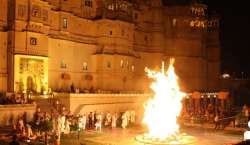Holika Dahan 2020: Significance, history, puja muhurat, date and vidhi
Celebrated a day before Holi is Holika Dahan that marks the victory of good over evil. Know the mythological story behind the celebration besides muhurat and puja vidhi.

When markets get decked up with heaps of colours, decorative materials and smell of gujiyas become irresistible, you know Holi is round the corner. There are reasons why India is called a vibrant nation and the festival of Holi is definitely one of them. Also known as Basant Utsav, Holi marks the onset of spring after a long winter. According to the Hindu lunar calendar, the two-day festival is observed on the full moon day (purnima) in the month of Phalgun. This year, Holi will be celebrated on March 10 while Holika Dahan is on March 9.
Celebrated a day before Holi is Holika Dahan that marks the victory of good over evil. On this day, holi pyres are lit on streets and open spaces. People do parikrama of the fire while singing and dancing. They also roast cereals and take it to their homes. Woods and combustible materials are gathered and put together Holi celebration begins soon after Holika Dahan.
Holika Dahan Significance And History
As per mythology, there once lived a powerful king, Hiranyakshyap, who wanted everybody to consider him God. But, his own son, Prahlad, an ardent devotee of Lord Vishnu, refused to bow down before him. To get rid of Prahlad, Hiranyakshyap asked his sister, Holika to sit on a blazing pyre with Prahlad on her lap. Holika had boon that she can escape fire unharmed. Prahlad kept chanting Lord Vishnu's name and hence, nothing happened to him while Holika died.
Holika Dahan Muhurat
Holika Dahan should be done during Pradosh Kaal (which starts after sunset) while Purnimasi Tithi is prevailing. Bhadra prevails during first half of Purnimasi Tithi and auspicious work shouldn't be done during Bhadra. As per drinkpanchang.com, Purnima Tithi will begin at 3:03 AM on March 9 and end at 11:17 PM. The duration of muhurat for Holika Dahan will be for 2 hours and 25 minutes. It will begin at 06:47 PM and end at 09:11 PM.
Holika Dahan Puja Vidhi
On Holika Dahan, people start gathering woods, twigs, branches, dried leaves and the Holika pyre is lit at an auspicious time in the evening. The bonfire has effigies of Holika and Prahlad, which is placed on the huge heap of woods. While the effigy of Holika is made of combustible material, that of Prahlad’s is made of non-combustible material.
After the fire is lit, people chant Rakshoghna Mantras of the Rig Veda in order to cast away the evil spirits. The ashes are collected next day in the morning and are smeared on the limbs. This is regarded as an act of purification.
Beads of cow dung, roli, akshat (rice which is not broken) incense sticks, dhoop, flowers, raw cotton thread, turmeric pieces, unbroken lentil of moong, batasha, gulal powder (colour) and coconut are used in the puja. Also, fully grown grains from freshly harvested crops like wheat and gram are roasted in puja and served as Holi prashad.
People sit down facing either East or North direction with small water pot and puja thali. While circumambulating the bonfire, three, five or seven rounds of raw yarn are tied around the Holika. After that water from the pot is poured in front of the fire. After the puja is concluded, people smear gulaal on each other and seek blessings from the elders.
The celebration and puja vidhi of Holika Dahan varies from region to region.